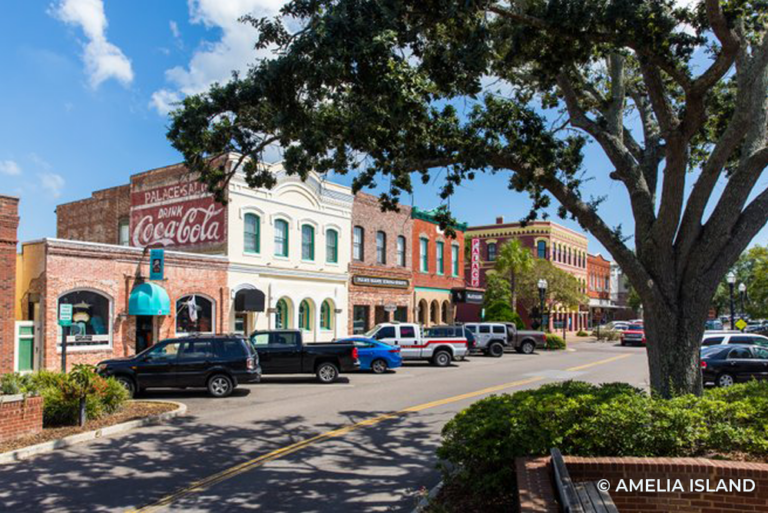



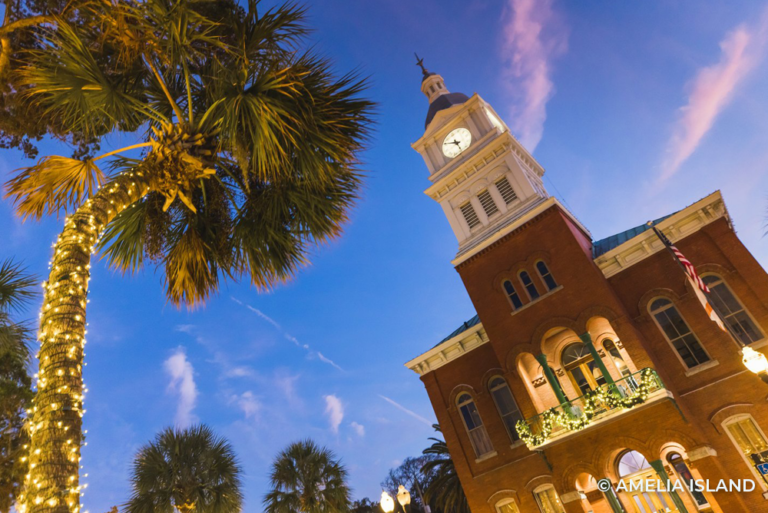


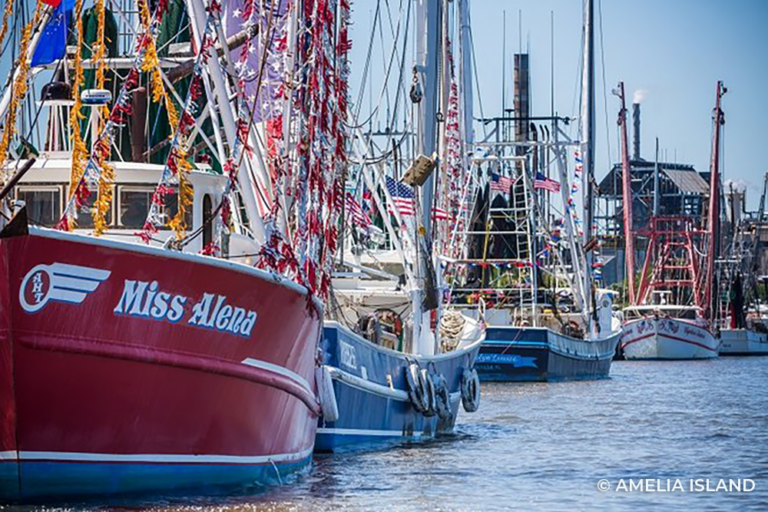









Amelia Island’s edges shift constantly. Made of sand, which is moved by waves, winds and tides, its border with the sea is not static. Plants of the dunes and salt marsh hold onto sand and sediment, holding back the sea and shaping the island. Being a strategic port with natural resources successive cultures have been drawn to live here.
Modern innovations in shrimping technique credited to Amelia Island residents include using motorised boats and weighted shrimp nets. Catching maritime bounty started with the island’s first people, the Timucua. In 1562 Jean Ribault, a French naval officer arriving on Florida’s shore wrote about fish wiers built by the Timucua “…so well and cunyngly sett together after the fashion of a labirinthe or maze, with so many tourns and crokes, as it is impossible to do it with more cuning or industrye.” [sic]
Visitors to Amelia Island are reminded to think about mariners to whom beaches are vitally important: sea turtles. Loggerhead turtles are the most common species using them for nesting. Rarely, green and leatherback turtles lay their eggs on the island too. After hauling out of the sea, turtles shuffle ashore and dig holes in which to lay their eggs, before returning to the water. Although the odds are against being on a beach at exactly the moment a turtle is in action or when hatchlings emerge from their eggs, you can spot the tracks they leave across the sand, which look like an imprint from a wide and rugged tyre. In order to protect turtles, beachgoers are asked to ensure they don’t leave rubbish on the beach, fill in holes dug in the sand, and knock down sand castles to leave flat sand. It’s also important that beachfront properties close their curtains to stop artificial light from illuminating beaches.
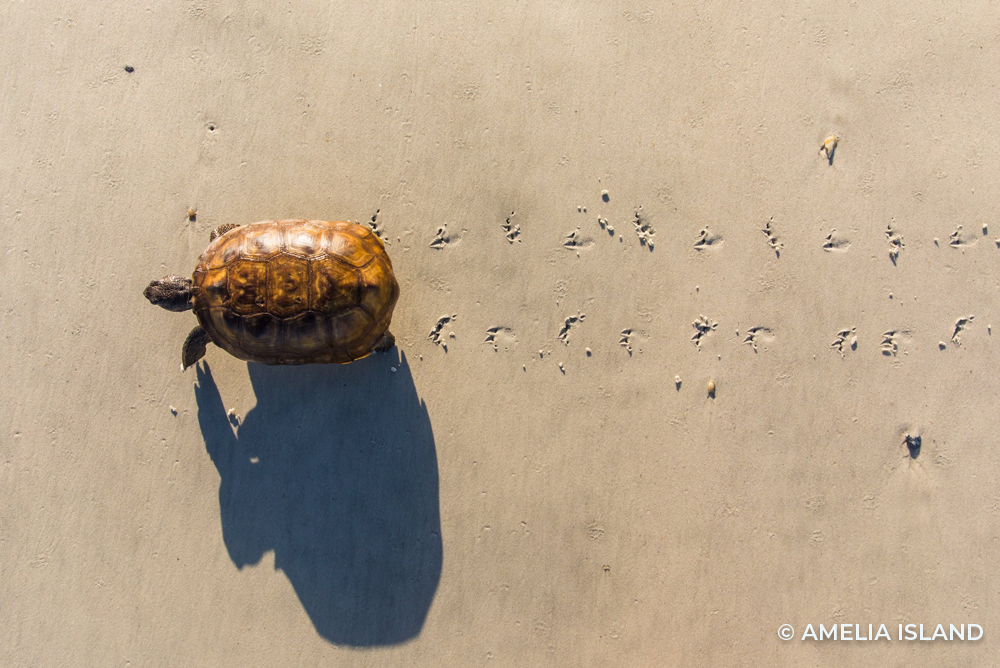
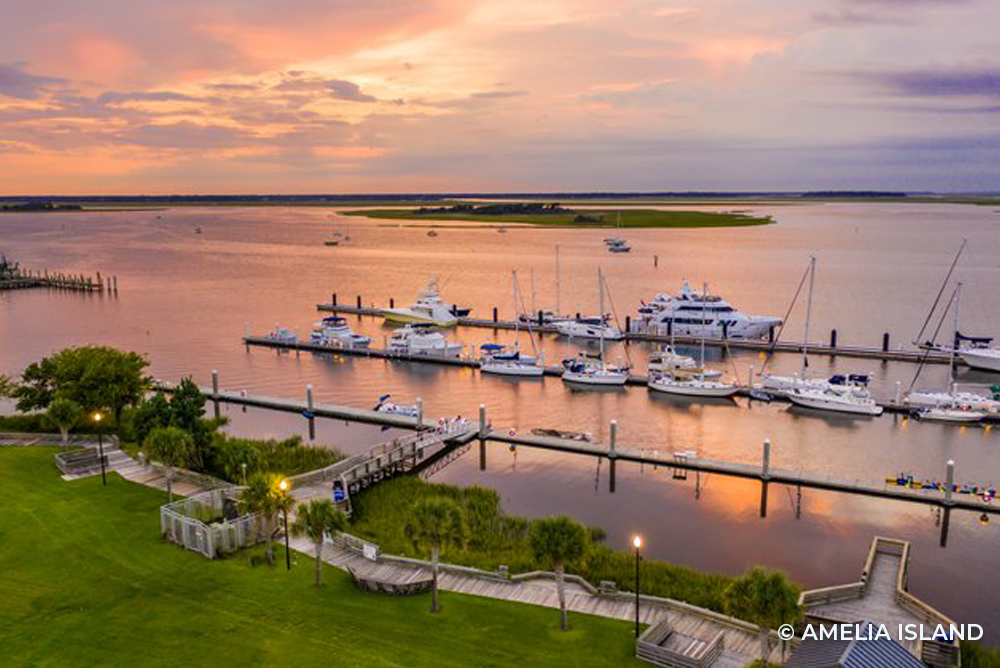
While being careful to avoid leaving traces on Amelia’s Islands beaches there are treasures you can collect; fossilized shark teeth. Collecting vertebrate fossils requires a permit, but no permit is needed for collecting fossilised shark teeth. St Mary’s River, which divides Georgia and Florida, empties into the Atlantic Ocean at the northern end of Amelia Island. Along with sediment, it drops fossilised shark teeth. Because ships need to pass through the channel, St Mary’s River is dredged, and the debris is put on the beaches of Fort Clinch State Park. Fossils are mixed in with sand. So, a walk along the tide line can reveal fossilised shark teeth.
Just beyond the water’s edge, beach pennywort is one of the plants that can grow in the extreme environment of dunes; it tolerates salty winds and stores water in its fleshy leaves. Sea oats stabilise dunes with their deep taproots and lateral rhizomes, their response to being covered with sand is to grow. However, trampling by footfall or driving over beach vegetation damages it.
Dunes are more than framing for scenic sunset and sunrise views, they dissipate wave energy and even mitigate waves generated by hurricanes. Little NaNa dune at American Beach is part of the dune system that nurtures inland areas of Amelia Island. Its shelter allows large plants like Spanish bayonet yucca and saw palmetto to become established and support dunes to grow higher. Tall ancient dunes provide enough protection to the interior of the island for the maritime forests to grow.
Underneath a canopy dominated by live oak, which is shaped by wind, the understory of maritime forest is rich with shrubs like sparkleberry a large blueberry, and beautyberry that has bright pink berries. As much a part of Amelia Island as beach views, the maritime forest is a lush backdrop to hiking trails.
Being on holiday is a time to slow down, and one of the best ways to do that is travelling at the speed of cycling. Amelia Island has relatively flat terrain, which makes cycling easy. The island is recognised as a Bicycle Friendly Community by the League of American Bicyclists, meaning that there is infrastructure supporting cycling. On Amelia Island, this includes car-free bike trails that give close-up views of wild scenery.
On this island that is only 13 miles long and two miles wide, you are never far from seeing the influence of the sea on the land.
Bring binoculars for a good look at birds without disturbing them. A pitstop on the north to south Atlantic flyway for birds, more than 300 species pass over or nest on the island. A highlight is Florida scrub jay, a rare bird that is endemic to Florida. Look out for them around oak scrub. Each autumn they cache thousands of acorns, then dig them up and eat them over winter and spring.
Alongside large marine animals such as manatees, dolphins, and sea turtles that people expect to enjoy seeing, small marine creatures can be as beautiful and fascinating. One way to get good views with commentary from experts is by going on an eco-shrimping tour. A trawl net is used to catch shrimp, which are then displayed in an on-board aquarium that allows a close look at their identifying features. Then the shrimp are released back in the sea.
While on an island it seems essential to go for a sea swim. Peters Point Beach has lifeguards on duty through the summer. While lifeguards watch out for people, an important way to take care of marine wildlife while enjoying being in the sea is to plan your protection from the sun in advance. If you are going to swim with sunscreen on, allow 20 minutes between application and swimming so that it soaks into your skin. Or protect your skin by covering up with a rash vest and swim leggings.
Egan’s Creek Greenway isn’t just for travel on land, the creek is navigable and you can join paddling tours that will give you views from the water. Wading birds—egrets, American wood storks, and in summer roseate spoonbills—are large and can be seen from a distance. Look down into the water and you might spot blue catfish and spotted sea trout.
Did you know that about 90% of sea turtle nesting in the U.S. takes place in Florida? Amelia Island is one of the idyllic spots where the ancient rituals of nesting and hatching unfold during the summer. Sea turtle nesting season is from May – October, and here you can find a list of things you can do to help protect baby turtles while enjoying the beach.

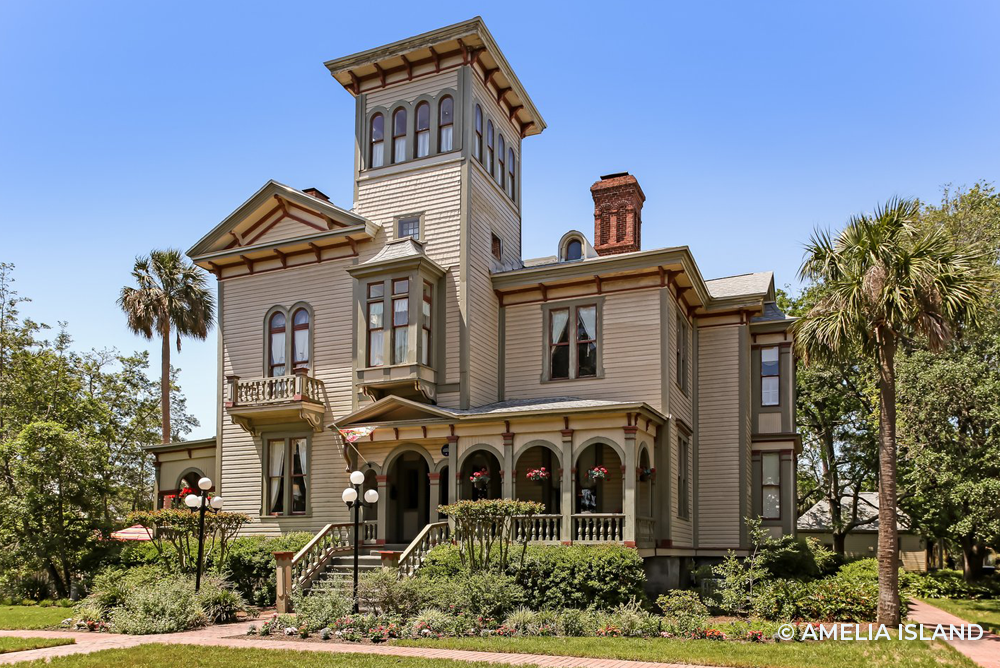
Price includes; 4 nights room-only stay at The Omni Amelia Island Resort, return flights, ATOL protection, and a free 5% donation to charity!
Check into The Omni Amelia Island Resort and spend the rest of the day exploring the pristine beaches of Amelia Island.
Stop for dinner at Burlingame Restaurant, known locally for its responsibly sourced seafood options from local fishermen.
Visit the Amelia Island Nature Center located at Omni Amelia Island Plantation Resort, where you can learn about the island’s ecosystems and conservation efforts.
Take a guided kayak tour with Amelia Island Kayak Excursions to explore the local waterways and observe the island’s wildlife while supporting a sustainable eco-tourism operator.
Engage in birdwatching at the Amelia Island Greenway, a preserved area that provides habitats for various bird species.
Enjoy dinner at David’s Restaurant & Lounge, which offers farm-to-table dishes featuring locally sourced ingredients.
Visit Fort Clinch State Park, a well-preserved historic fort surrounded by natural beauty. Learn about the park’s conservation efforts and take a guided tour of the fort.
Explore the local historic district in downtown Fernandina Beach, walking or cycling to reduce carbon emissions. Visit the Amelia Island Museum of History to learn about the island’s cultural heritage and preservation initiatives.
Rent bicycles from Kayak Amelia and explore the island’s bike-friendly trails, including the Egans Creek Greenway, which provides a scenic route through preserved wetlands.
Participate in a guided nature hike with Amelia Island Guides to learn about the island’s flora, fauna, and conservation efforts.
Enjoy an outdoor picnic using locally sourced food from the Fernandina Beach Market Place farmers’ market, held on Saturdays, supporting sustainable agriculture and local vendors.
For dinner, dine at Timoti’s Seafood Shak, a restaurant that focuses on sustainable seafood options and partners with local suppliers.
Return to the UK today, but before leaving, make sure to properly dispose of waste, recycling whenever possible.
Consider supporting local environmental organizations like the Wild Amelia Nature Festival, which promotes conservation and education about the island’s natural resources.
Reflect on your sustainable travel experiences and share your insights with others to promote eco-conscious tourism.
Support local sustainable businesses by purchasing eco-friendly souvenirs made by local artisans.
Price includes; 2 nights in St. Augustine, 4 nights in Amelia Island, 1 night in Gainsville, return flights, car hire, ATOL protection, and a free 5% donation to charity!
Depart from Orlando International Airport and drive to St. Augustine.
Sustainable highlights: Explore St. Augustine’s historic district by foot or bike to minimise your carbon footprint. Visit the St. Augustine Lighthouse & Maritime Museum, which focuses on coastal conservation and preservation efforts.
Spend a full day in St. Augustine.
Sustainable highlights: Take a guided eco-friendly boat tour on the St. Johns River to learn about the local ecosystem and wildlife conservation. Visit the St. Augustine Alligator Farm Zoological Park, which is committed to wildlife conservation and education.
Drive to Amelia Island.
Sustainable highlights: Check into a sustainable accommodation on Amelia Island that emphasizes eco-friendly practices, such as energy conservation and waste reduction. Explore the island’s beautiful beaches and participate in beach clean-up activities to help preserve the coastal environment.
Explore Amelia Island.
Sustainable highlights: Rent bicycles and explore the island’s bike-friendly trails and paths. Visit Fort Clinch State Park, known for its natural beauty and historical significance, and learn about its conservation efforts. Consider dining at local restaurants that prioritize sustainable sourcing and farm-to-table practices.
Explore Amelia Island.
Explore the local historic district in downtown Fernandina Beach, walking or cycling to reduce carbon emissions. Visit the Amelia Island Museum of History to learn about the island’s cultural heritage and preservation initiatives.
Explore Amelia Island.
Sustainable highlights: Visit the Amelia Island Nature Center and take part in educational programs focused on environmental conservation. Enjoy outdoor activities like kayaking, paddleboarding, or birdwatching while respecting the natural surroundings. Consider supporting local artisans and businesses that promote sustainable practices.
Head back towards your starting location, with a stop in Gainesville.
Sustainable highlights: Visit the University of Florida’s Butterfly Rainforest, a sustainable exhibit that educates visitors about butterfly conservation and the importance of protecting pollinators. Explore Gainesville’s downtown area by foot, supporting local shops and restaurants that prioritize sustainability and local sourcing.
Return home via Orlando airport
Get in touch with our expert travel agents to plan your perfect trip to Amelia Island today!
Remember, every time you book a holiday with Charitable Travel, you can donate 5% of the price to the charity of your choice for free!



Fundraising Futures Community Interest Company, Contingent Works, Broadway Buildings,
Elmfield Road, Bromley, Kent,
BR1 1LW. England
Putting our profit to work supporting the work of charitable causes











For the latest travel advice, including security, local laws and passports, visit the Foreign & Commonwealth Office website.
© 2024 All rights reserved
Made with 
| Cookie | Duration | Description |
|---|---|---|
| AWSELB | session | Associated with Amazon Web Services and created by Elastic Load Balancing, AWSELB cookie is used to manage sticky sessions across production servers. |
| cookielawinfo-checkbox-advertisement | 1 year | Set by the GDPR Cookie Consent plugin, this cookie is used to record the user consent for the cookies in the "Advertisement" category . |
| cookielawinfo-checkbox-analytics | 11 months | This cookie is set by GDPR Cookie Consent plugin. The cookie is used to store the user consent for the cookies in the category "Analytics". |
| cookielawinfo-checkbox-functional | 11 months | The cookie is set by GDPR cookie consent to record the user consent for the cookies in the category "Functional". |
| cookielawinfo-checkbox-necessary | 11 months | This cookie is set by GDPR Cookie Consent plugin. The cookies is used to store the user consent for the cookies in the category "Necessary". |
| cookielawinfo-checkbox-others | 11 months | This cookie is set by GDPR Cookie Consent plugin. The cookie is used to store the user consent for the cookies in the category "Other. |
| cookielawinfo-checkbox-performance | 11 months | This cookie is set by GDPR Cookie Consent plugin. The cookie is used to store the user consent for the cookies in the category "Performance". |
| elementor | never | This cookie is used by the website's WordPress theme. It allows the website owner to implement or change the website's content in real-time. |
| JSESSIONID | session | Used by sites written in JSP. General purpose platform session cookies that are used to maintain users' state across page requests. |
| viewed_cookie_policy | 11 months | The cookie is set by the GDPR Cookie Consent plugin and is used to store whether or not user has consented to the use of cookies. It does not store any personal data. |
| Cookie | Duration | Description |
|---|---|---|
| __lc_cid | 2 years | This is an essential cookie for the website live chat box to function properly. |
| __lc_cst | 2 years | This cookie is used for the website live chat box to function properly. |
| __oauth_redirect_detector | past | This cookie is used to recognize the visitors using live chat at different times inorder to optimize the chat-box functionality. |
| aka_debug | session | Vimeo sets this cookie which is essential for the website to play video functionality. |
| player | 1 year | Vimeo uses this cookie to save the user's preferences when playing embedded videos from Vimeo. |
| Cookie | Duration | Description |
|---|---|---|
| AWSELBCORS | 6 minutes | This cookie is used by Elastic Load Balancing from Amazon Web Services to effectively balance load on the servers. |
| Cookie | Duration | Description |
|---|---|---|
| _ga | 2 years | The _ga cookie, installed by Google Analytics, calculates visitor, session and campaign data and also keeps track of site usage for the site's analytics report. The cookie stores information anonymously and assigns a randomly generated number to recognize unique visitors. |
| _gat_gtag_UA_164521185_1 | 1 minute | This cookie is set by Google and is used to distinguish users. |
| _gid | 1 day | Installed by Google Analytics, _gid cookie stores information on how visitors use a website, while also creating an analytics report of the website's performance. Some of the data that are collected include the number of visitors, their source, and the pages they visit anonymously. |
| _hjAbsoluteSessionInProgress | 30 minutes | No description available. |
| _hjFirstSeen | 30 minutes | This is set by Hotjar to identify a new user’s first session. It stores a true/false value, indicating whether this was the first time Hotjar saw this user. It is used by Recording filters to identify new user sessions. |
| _hjid | 1 year | This is a Hotjar cookie that is set when the customer first lands on a page using the Hotjar script. |
| _hjIncludedInPageviewSample | 2 minutes | No description available. |
| CONSENT | 16 years 3 months 16 days 17 hours 23 minutes | These cookies are set via embedded youtube-videos. They register anonymous statistical data on for example how many times the video is displayed and what settings are used for playback.No sensitive data is collected unless you log in to your google account, in that case your choices are linked with your account, for example if you click “like” on a video. |
| iutk | 5 months 27 days | This cookie is used by Issuu analytic system. The cookies is used to gather information regarding visitor activity on Issuu products. |
| vuid | 2 years | Vimeo installs this cookie to collect tracking information by setting a unique ID to embed videos to the website. |
| Cookie | Duration | Description |
|---|---|---|
| IDE | 1 year 24 days | Google DoubleClick IDE cookies are used to store information about how the user uses the website to present them with relevant ads and according to the user profile. |
| mc | 1 year 1 month | Quantserve sets the mc cookie to anonymously track user behaviour on the website. |
| NID | 6 months | NID cookie, set by Google, is used for advertising purposes; to limit the number of times the user sees an ad, to mute unwanted ads, and to measure the effectiveness of ads. |
| test_cookie | 15 minutes | The test_cookie is set by doubleclick.net and is used to determine if the user's browser supports cookies. |
| VISITOR_INFO1_LIVE | 5 months 27 days | A cookie set by YouTube to measure bandwidth that determines whether the user gets the new or old player interface. |
| YSC | session | YSC cookie is set by Youtube and is used to track the views of embedded videos on Youtube pages. |